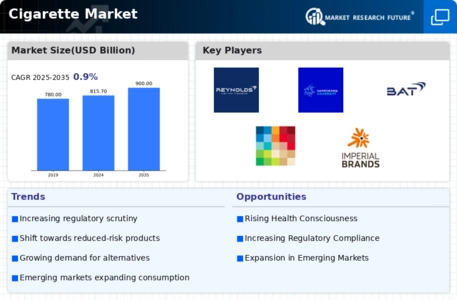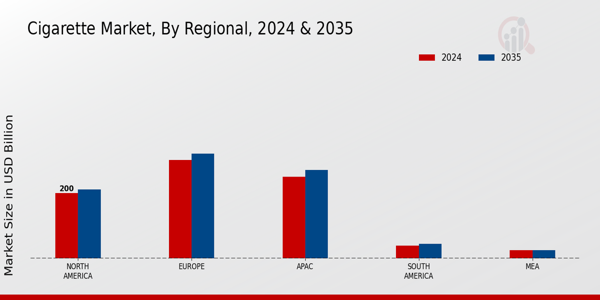Emerging Markets
Emerging markets present a unique opportunity for the Global Cigarette Market Industry, as rising disposable incomes and urbanization drive consumption. Countries in Asia and Africa are witnessing an increase in cigarette consumption, fueled by a growing middle class. For instance, the demand for premium cigarette brands has surged in markets like India and Nigeria, where traditional smoking habits are evolving. This trend could contribute to a compound annual growth rate of 0.9% from 2025 to 2035, indicating a potential for sustained growth in these regions despite global health initiatives.
Product Innovation
Innovation within the Global Cigarette Market Industry plays a crucial role in attracting consumers and maintaining market share. Manufacturers are increasingly focusing on developing new products, such as reduced-risk tobacco products and e-cigarettes, to cater to health-conscious consumers. For example, the introduction of heated tobacco products has gained traction in various markets, appealing to smokers seeking alternatives to traditional cigarettes. This shift towards innovative offerings may help the industry navigate regulatory challenges and consumer preferences, ultimately supporting the market's projected growth trajectory.
Regulatory Environment
The Global Cigarette Market Industry is heavily influenced by regulatory frameworks that vary across regions. Governments implement stringent laws aimed at reducing smoking rates, such as higher taxes on tobacco products and advertising restrictions. For instance, countries like Australia and Canada have adopted plain packaging laws, which appear to deter smoking initiation among youth. These regulations not only impact consumer behavior but also compel manufacturers to adapt their marketing strategies. As a result, the market is projected to reach approximately 815.7 USD Billion in 2024, reflecting the ongoing challenges posed by regulatory measures.
Health Awareness Campaigns
Increasing health awareness campaigns globally contribute significantly to the dynamics of the Global Cigarette Market Industry. Public health organizations and governments are actively promoting the dangers of smoking, leading to a decline in smoking prevalence in various demographics. For example, anti-smoking campaigns in the United States have resulted in a notable decrease in adult smoking rates over the past decade. This heightened awareness may lead to a projected market value of 900 USD Billion by 2035, as the industry adapts to changing consumer preferences and seeks to mitigate the impact of health-related concerns.
Market Trends and Projections
The Global Cigarette Market Industry is characterized by evolving market trends and projections that reflect changing consumer behaviors and preferences. The market is anticipated to reach approximately 815.7 USD Billion in 2024, with a gradual increase to 900 USD Billion by 2035. This growth trajectory suggests a compound annual growth rate of 0.9% from 2025 to 2035, indicating a potential stabilization of the market amidst regulatory pressures and health awareness initiatives. Understanding these trends is essential for stakeholders to navigate the complexities of the industry and make informed strategic decisions.
Social Acceptance and Cultural Factors
Cultural attitudes towards smoking significantly influence the Global Cigarette Market Industry. In certain regions, smoking remains socially acceptable and is often associated with status or lifestyle. For instance, in parts of Eastern Europe and Asia, smoking is deeply ingrained in social customs, which may sustain demand for cigarettes despite health warnings. This cultural acceptance could counterbalance the effects of health campaigns, allowing the market to maintain a steady presence. As a result, the industry may continue to thrive, adapting to local customs while navigating global health trends.







